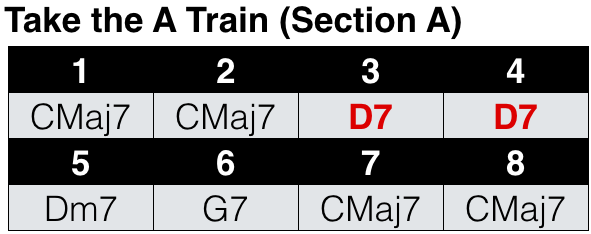Definition
Modulation occurs when a song changes key for a long period of time (at least 1 phrase or more than 1 bar) and is often, though not always, confirmed with a V-I cadence. Changing key for less than a phrase or for a bar or less is instead called toncisation.
Types of Modulation
Modulations are very common in Jazz. Very few jazz songs stay in one key for the whole song, and some don’t stay in one key for more than 2 bars. In Jazz, the most common types of modulation are:
- Unprepared/Direct modulation – which modulates to the next key with a I chord.
Many songs use this kind of modulation, especially between sections. Modal Jazz songs like So What and Impressions use this type of modulation when they move from the key of D Dorian in part A of the song, to E♭ Dorian in part B. - Prepared modulation – which modulates to the next key by preparing the new I chord with a V or ii-V. So you’re given a bit of warning before you encounter the next tonic chord.
How High the Moon does this with the chord progression:
GMaj7 | GMaj7 | Gm7 | C7 | FMaj7 | FMaj7 | Fm7 | B♭7 | E♭Maj7 ||
And changing the chord quality while keeping the same root notes, as is done here, is very common. - Pivot Chord modulation – which uses a diatonic chord common to two keys to pivot from one key to the other, such that the pivot chord is in both keys.
For example, take the chord progression:
Dm7 | G7 | CMaj7 | Em7 | A7 | DMaj7 ||
This looks like a ii-V-I in C followed by a ii-V-I in D, but looking closer we see that the Em7 chord is both in the key of C and D Major, so is arguably in both keys at once.
The song Autumn Leaves does this as it modulated from the key of B♭Maj to its relative Gmin:
Cm7 | F7 | B♭Maj7 | E♭Maj7 | Am7♭5 | D7 | Gm7 | Gm7 || - Transitional/Chain modulation – which uses a succession of ii-V’s to quickly move through a number of different keys, moving down by a semitone, tone or fifth. Though this could arguable be tonicisation.
Blues for Alice does this:
FMaj7 | Em7♭5 A7 | Dm7 G7 | Cm7 F7 | B♭7 ||
As does In Your Own Sweet Way:
Am7♭5 D7 | Gm7 C7 | Cm7 F7 | B♭6 ||
Modulation to Where?
And most modulations change key to the:
- Relative Major or minor (C Major to A minor)
- Parallel Major or minor (C Major to C minor)
- A key closed related on the circle of fifths and so sharing many notes in common (C Major [no sharps of flats] to F Major [one flat] or G Major [one sharp])
There are other types of modulation – like common-tone modulation, enharmonic modulation, chromatic-tone modulation – but these aren’t really common to Jazz, they are more applicable to Classical.
Tonicisation
If the key changes for a short period of time, before concluding that a modulation has taken place, always look for:
As these are often a better explanation for chords in a different key – especially if there is no confirming V-I cadence.
An Example
And when analysing a chord progression, always look at the chords in an entire section, as this will give you more context as to what is happening. And keep in mind that there are many ways to analyse the same chord progression. And some are genuinely difficult to analyse. Look at the Jazz Standard: Take the A Train. Section A of the chord progression goes as follows:

Looking at the first 4 bars, this looks like a simple IV-V movement in G. The melody even start on the note G. But looking at the next 4 bars we see that we are actually in the key of C. We never confirm the cadence by resolving to the GMaj7. As such, I think it is better to analyse the D7 as a:
- II7 borrowed chord from the Lydian Mode; or
- V/V Secondary Dominant resolving to the G7 but with a ii passing chord inserted before it to delay the cadence and create a ii-V movement.
So I would say this whole section is in the key of C with a borrowed chord or secondary dominant creating a delayed cadence. But you’re welcome to disagree.